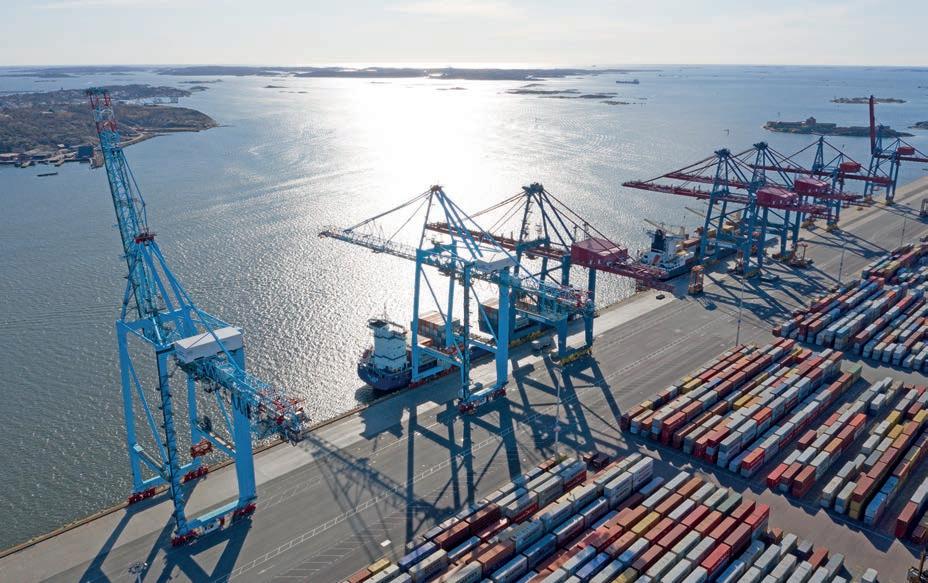
41 minute read
Targeting Zero Carbon Footprints
How are ports helping to reduce emission levels to zero in the operation of container handling? John Bensalhia reports on modern day design and technology use
As a result of environmentally friendly initiatives and investments, ports around the world are targeting clean, emission-free operations. A notable example is APM Terminals Gothenburg, which has cut the rate of emissions by 90%. The company’s Green Gothenburg Gateway concept creates renewable energy, enabling all customers to receive fossil-free transport through the terminal at no extra cost.
APM Terminals Gothenburg has also announced that it will be making its container handling operations fossil-free. “All container handling equipment runs on HVO 100, all cranes and gates run on renewable electricity and biogas is used for heating,” says Cajsa Levén, Marketing Communication Coordinator. “These actions reduce APM Terminals’ climate footprint in Gothenburg by approximately 90%. All customers are also offered fully climate-neutral cargo handling through APM Terminals’ Low Carbon Logistics program. The program is a way to reduce carbon dioxide emissions by investing in our own supply chain. This strengthens our contribution to the Swedish business sector’s competitiveness and climate work.” Another initiative introduced by APM Terminals Gothenburg is an increase in the container terminal’s capacity. “A high container capacity is key to reducing climate impact,” explains Levén. ”Vessels that can maintain normal speed minimise climate impact. The fast handling times at our terminal help vessels keep their timetables, without needing to run at extra high speeds and consume more fuel.”
A vessel that needs to travel 10% faster to recoup lost time increases its fuel consumption (hence its emissions) by 20%. “APM Terminals in Gothenburg therefore ensures that vessels that arrive late still depart on time,” says Levén. “The most recent survey showed that 22% of vessels arrive later than scheduled; nevertheless, 97% leave the terminal within (or earlier than) the stipulated time. This is possible thanks to the capacity-enhancing investments and changes made by APM Terminals.”
Another important climate measure is to move freight transport from truck to train. APM Terminals Gothenburg is doubling rail volumes by 2022. Transporting goods by train not only offers economic advantages, but also reduces emissions by up to 98% compared to road transport.
From a zero-emission equipment angle, the Port of Valencia’s H2Ports project concentrates on testing heavy-duty, hydrogen fuel cell-powered port equipment. Two cargo terminals at the Port (MSC Terminal Valencia and Valencia Terminal Europe) will trial prototype equipment of a container handling reach stacker and a terminal tug master for ro-ro operations.
8 Ports around the world are targeting clean, emission-free operations – but what are they doing to achieve it?
EQUIPMENT MANUFACTURERS HELPING PORTS? Manufacturers of container handling equipment are helping ports achieve their goal. Arto Keskinen, SVP Kalmar Automation Solutions, says that Kalmar’s credentials in developing electrically powered equipment go back into the 1970s, and since then, the company has extended its offering with dieselelectric, hybrid and electrically-powered machines to help customers improve their productivity and reduce air emissions, noise and fuel consumption of their operations.
AUTOMATION FOR TERMINAL OPERATIONS

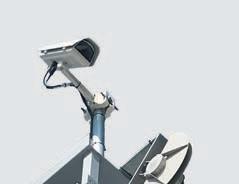
Visy provides software and system solutions that enable terminals to automatically identify and record everything going in or out of the terminal by road, rail or quay, or being moved in the yard. By interfacing with 3rd party systems, Visy systems allow terminals to reach new levels of productivity and efficiency.

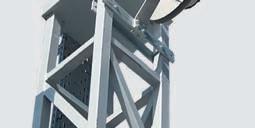

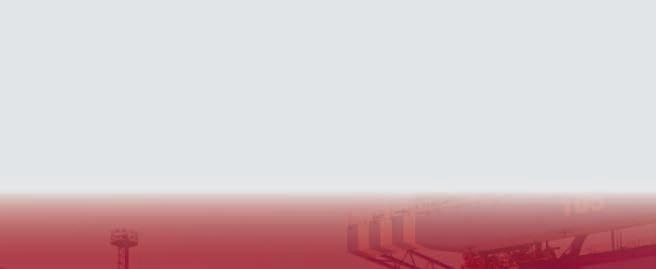
YOUR FLEXIBLE OCR PARTNER Finland-Sweden-Norway-Estonia-Latvia-Poland-Germany-Holland-Belgium-United Kingdom-Ireland-Morocco-Egypt-Romania-Kazakhstan-China-Japan-Indonesia-Brazil ...
GATE OPERATING AND CRANE OCR SYSTEMS WITH EXTENSIVE AUTOMATION AND AI FEATURES
Expand your vision
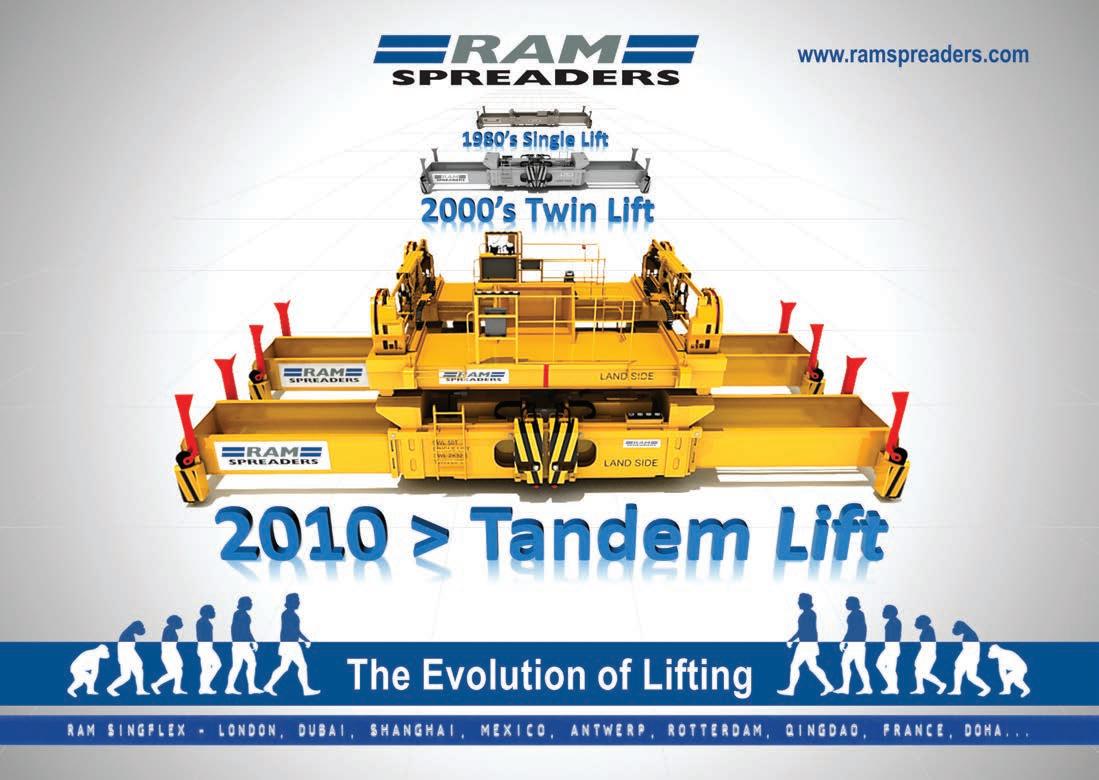

sales@visy.fi www.visy.fi
BOOTH A2
“Kalmar’s rail-mounted STS and yard crane offering has been electrically powered for decades, and we introduced the world’s first mains-powered RTG in 2002. Today, over 50% of Kalmar cargo handling equipment is already available with electric power sources,” Keskinen outlines.
In December 2015, Kalmar introduced a fast-charging solution for electric-powered shuttle and straddle carriers that was extended to hybrid machines in June 2016. The Kalmar FastCharge solution is based on the same technology used in electric buses. “The charging station with a pantograph direct current charging system is located flexibly on the working route of the machines in the terminal,” explains Keskinen. “The machine has modern Lithium-ion (Liion) batteries which enable fast charging to be used. Charging happens during the idle time in the machine working cycle when it has stopped to wait for the container. Typical charging time in operation is 30 to 180 seconds, and with the maximum charging power of 600 kW, full charge can be achieved in a few minutes.”
Electrification is one of the main trends in clean container handling. In May 2018, Kalmar announced its commitment to reduce emissions in cargo and material handling operations by fostering eco-efficient technologies. According to the commitment, Kalmar’s full offering will be available as electrically powered versions by 2021.
“In line with our eco-efficiency target, we introduced the Kalmar Ottawa Electric Terminal Tractor to the Americas market in May 2018,” says Lasse Eriksson, VP Technology, Kalmar. “The electric terminal tractor with a fully electric powertrain that produces zero emissions at source is designed for trailer-handling operations in dispersed warehouses, container terminals and other applications where short-distance highway travel is required.”
Kalmar continued on its electrification journey by introducing a fully electric version of the Kalmar Empty Container Handler. “The machine is designed to help customers reduce overall fuel costs and comply with increasingly strict airborne and noise emissions standards without compromising on performance,” explains Eriksson.
As well as being environmentally sound, electrification and automation offer other significant advantages, such as for terminals operating Rubber-Tyred Gantry (RTG) cranes. “Hybrid, cable reel and busbar-based systems each have their own unique strengths,” says Arto Keskinen. “The choice of the crane electrification solution needs to be considered carefully while taking into account the automation level and development roadmap of the entire terminal.”

HOW AUTOMATION CAN HELP Automation can benefit ports in a number of ways, with respect to costs, reduced operational time (saving the problem of operators moving to and from the cranes) and improved productivity of crane operators (the result of one operator controlling multiple RTGs remotely).
In 2018, Konecranes Lift Trucks introduced the Powered by Ecolifting concept to the market. This includes all the technical features developed on Konecranes’ lift trucks, granting a reduction in fuel consumption and noise level, which consequently contributes to issue less emissions in the air (carbon and noise emissions).
“With our Ecolifting solutions you can both save money and make better choices for the environment by using less fossil fuels without compromising on performance,” says Patrik Lundbäck, Director and Head of Sales & Distribution, BU Lift Trucks, Konecranes.
“The solutions that have been implemented are mainly three: Power Drive; Flow Drive; and Hybrid Drive, but there are others in the pipeline,” he confirms.
Taking the first of these solutions, Lundbäck says that the Power Drive offers an affordable and convenient method of reducing emissions and costs. “With Power Drive at first, it is possible to take important steps in emission reduction, without major changes to the infrastructure or training of the staff. It is
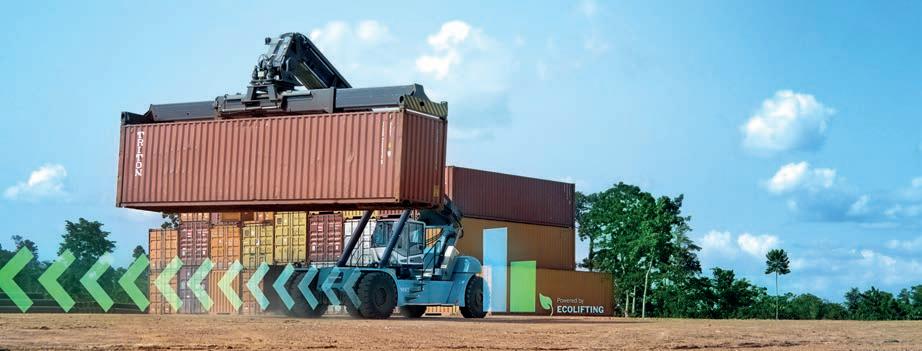
8 Electrification is a key step forward in clean container handling
8 Kalmar’s electric equipment reduces airborne and noise emissions
FASTER + GREENER CONTAINER HANDLING
Multiple container handling means: • Faster vessel turn around • Speeds up empty and laden handling • Fewer vehicle and crane movements • Improved safety
• BLOK Trailer 4 or 8 TEU jigged/moved as one
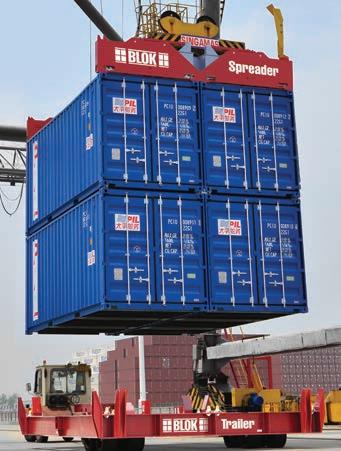
• BLOK Spreader 2 or 4 empties in one lift


• BLOK Rig 4 or 8 SATS/FATS automatic twistlocking in seconds
Blokcontainersystems.com
www.elme.com THIS IS ELME No 3 THE VISION
PERFECTION IN SPREADER ENGINEERING
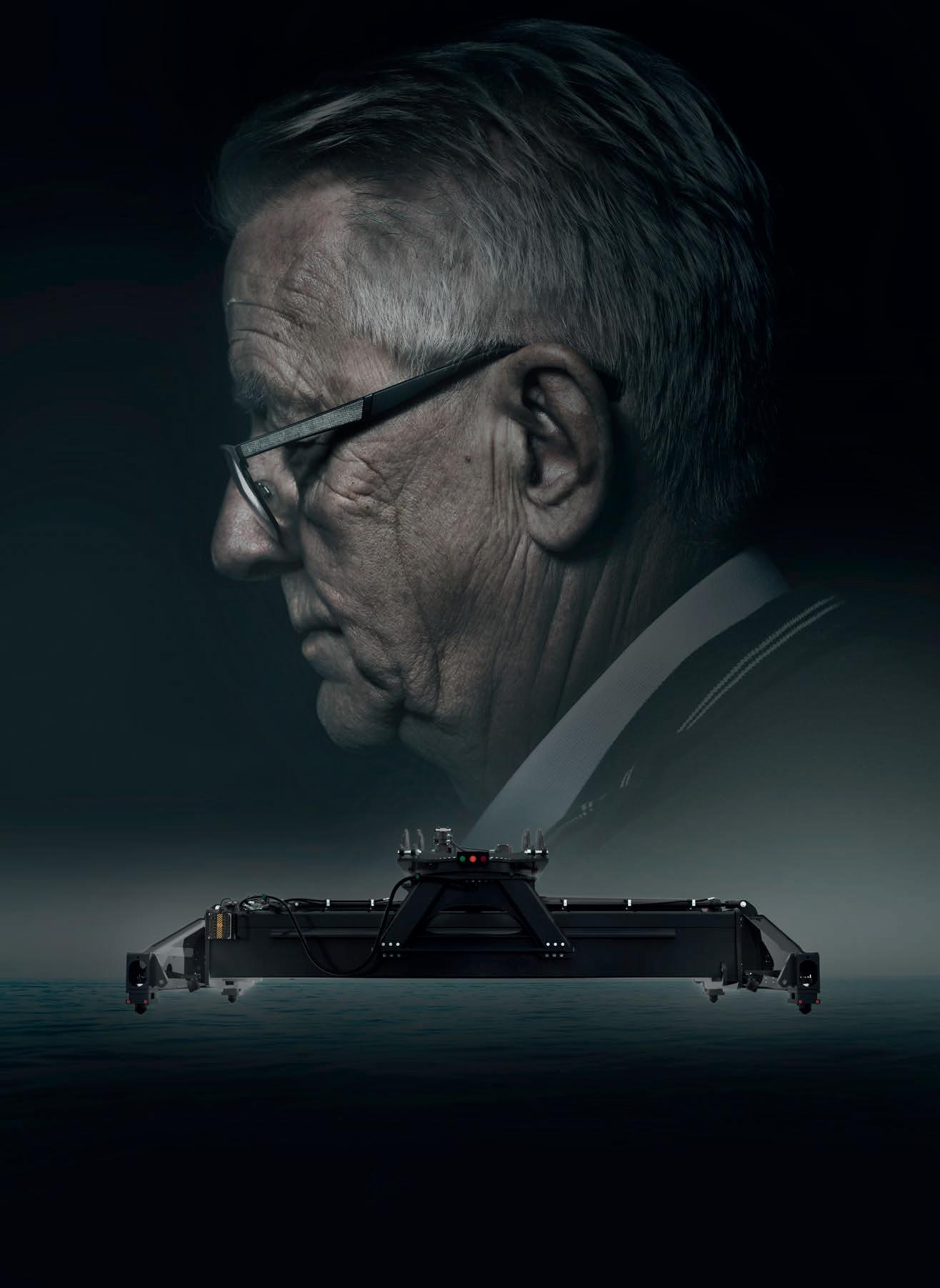
The Vision of Gösta Karlsson – the founder and president of ELME Spreader – is a continuing success story, told from the deep forests of Småland since 1974.
Gösta once stated ”the better spreaders we manufacture, the more value we bring to our customers”. His vision, to produce world leading spreaders, is the North Star for people at ELME. In line with that – no efforts are spared developing our New Generation Spreaders. We call that ’perfection in spreader engineering’.
the most cost-efficient way to start reducing emissions and fuel expenses, thanks to a very short payback time. It saves on fuel and costs, reducing consumption by up to 15%.”
With a relatively small extra investment, Flow Drive has a drive line that offers up to 25% in reduction, combined with an improved working environment for the drivers.
“With a minimal financial investment, this solution brings concrete benefits to everyday operations,” Lundbäck explains. “A precise, smooth ride, reduced noise and less cabin vibration and a significant increase in overall productivity.”
The third solution, Hybrid Drive, as Lundbäck comments, is the one with a bigger impact in customer operations. “The difference with the diesel engine driven trucks is higher due to the fully electric propulsion and lifting. Leading the next generation of sustainable lift trucks, Hybrid Drive cuts down the fuel consumption up to 40%, providing benefits to business, users, processes and the environment. The evolution of the world’s first Hybrid Reach stacker grants benefits in terms of reduced emissions and cost efficiency, which are much more significant than the first two options, being also the bigger investment.”
COST REDUCTION BENEFITS Considering that environmentally friendly container handling products reduce fuel and noise consumption, one of the additional benefits is cost reduction.
“Less quantity of fuel will be used and therefore, purchase quantities will be reduced, turning into a main cost decrease per running hour,” says Lundbäck, adding, “With our Ecolifting solutions, you can both save money and make better choices for the environment by using less fossil fuels without compromising on performance.”
The combination of factors such as technological inroads, emission-free equipment/machinery and a greater awareness /understanding of keeping the environment clean is pushing clean container handling further towards zero.
“Equipment with completely zero emissions will be a certainty in the future, for sure,” says Patrik Lundbäck. “We will see a trend in which the terminals will turn into fully electric hubs.”
Robert Bernardo agrees that more ports are moving towards all-electric container terminals. “This is being studied in tandem with moving towards partial or full automation of cargo terminals – since the capital investment needed for both can be accomplished at the same time. More federal and state funding will be needed to help
provide incentives so that container ports move toward electric equipment. Also, long-shore labour may be opposed to automation because it will reduce jobs for dock workers.” Lasse Eriksson adds a further comment here relating to costs. “It is important to note that electrification is not only about improving your green credentials, it can also mean a decrease in operational costs. Eco-efficiency is the future of cargo and material handling, with new and more advanced technologies helping us to do more with less.”
The executive offers a concluding summary too. “At Kalmar, eco-efficiency means systems efficiency, enabling continuous improvements with automation technologies and smart data gathering and analysis. It also means emissions efficiency - cutting atmospheric emissions with electrification, the latest driveline technologies, and better operator training. Finally, it also means resource efficiency, taking a proactive approach to maintenance to keep equipment operating optimally, delivering smart upgrades that help customers move more with less, and focusing on optimising our own operations as well as those of our suppliers.”

8 Is more State funding needed to help ports move towards electric equipment?
No Dreaming in California
Reducing emission levels of cargo handling equipment has been part of strategies introduced by the Ports of L ong Beach and Los Angeles. The Clean Air Action Plan not only lowers the pollution from equipment, but also vessels, trains and trucks. The outcome is a drop of more than 85% for particulate matter, a 50% reduction for nitrogen oxides and 95% less sulfur oxides. The end game of the plan is that the two ports’ fleets will be completely zero-emission by 2030. The plan has seen the r eplacement and upgrades of older, diesel-powered equipment, with trials of modern zero-emission yard tractors and cranes. The P ort of Los Angeles introduced a rule in 2008 that banned access for trucks built before 1989. A follow-up ban outlawed any trucks that did not meet the requirements of the 2007 emission standards. The process was taken a step further in 2018 with the rule that only trucks constructed in 2014 or after will qualify for sign-up in the Port Drayage Truck Registry.
The Northern Californian Port of Oakland has its own initiatives, such as using hybrid rubber-tyre gantry cranes at its O akland International Container Terminal.
“These hybrids use diesel engines and electric motors to reduce emissions,” explains Robert Bernardo, Communications Manager, Port of Oakland. “Also, several port tenants are beginning to test all-electric trucks for use in moving cargo containers within the yard.”
He explains further. “The main benefits of using these include lower carbon dioxide emissions, lower particulate matter pollution, less noise, less money spent on petroleum-based fuels, and less life-cycle costs for equipment (because of much lo wer maintenance and fuel costs for electric equipment).”
TUG DESIGN GOES HI-TECH IN SEARCH OF OPTIMISATION
Digitalisation is a driving force as tug manufacturers capture data from the tug’s operating performance to enhance design improvements and modifications, as Dave MacIntyre discovers
Performance optimisation is a key goal at a time when ships are getting ever larger but port constraints such as berths, turning circles and approaches remain fixed. So, manufacturers are using remote monitoring and other means to retrieve all digital data available on the vessel’s operation. They make use of existing sources onboard, like the alarm and monitoring system, navigation and communication equipment and any additional systems onboard that generate data. Additional sensors can be placed for specific functionality. Data is then used to optimise the design and improve the operational uptime for the client, such as a port.
The importance digitalisation has assumed is underlined by Arnout Damen, Chief Executive Officer at Damen Shipyards Group NV, who says it is an ongoing development that is becoming more important to clients and to sustainability.
“We will build our ships cradle-to-cradle – all materials used will be usefully applied to another product after the ship is scrapped – and ensure it sails emission-free. Being able to digitalise is critical,” he confirms, before adding, “You need that constant flow of information about the performance of a ship to determine, for example, the optimally-economic and most-sustainable sailing speed and to plan predictive maintenance.”
Yet Damen adds a word of caution too. “But digitalisation is also an economic law. Onshore operators can monitor multiple ships and solve problems remotely using virtual reality and artificial intelligence.”
For this reason, the group has established a focused digital platform called Damen Triton.
Damen says its goal is to put data to work in the areas of safety, sustainability and efficiency. Sjoerd de Bruin, Sales Manager Asia Pacific explains further. “Initial focus is on fuel consumption, but also on the data that assists us to provide better after-sales support to our clients in case of a technical issue.…furthermore, design parameters to improve our designs and be able to come with better solutions in the future are important.”
An example of data capture leading to design enhancements relates to the fuel consumption of the generators. For a specific harbour operation, the use of electrical shore power instead of the generator when the vessel is alongside the quay will save a significant amount of fuel, emissions and maintenance.
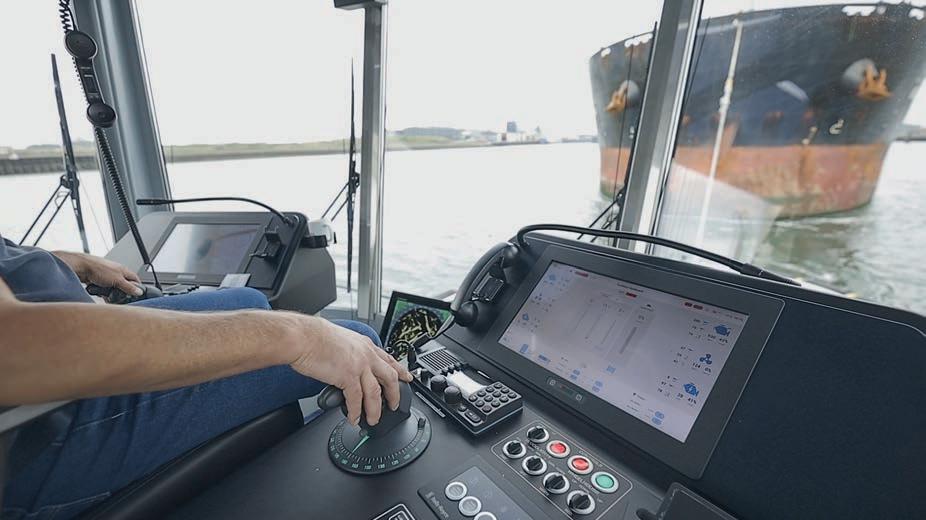
8 The RSD 2513 Multratug monitor
PREDICTIVE MAINTENANCE De Bruin says predictive maintenance leads to more reliable assets. “This is a development that is ongoing in many different sectors and requires close cooperation with equipment manufacturers, since these are best aware of the characteristics and maintenance profiles of their products.”
In terms of next steps, he is also clear. “Context data is available through Damen Triton. We will slowly move towards new models like predictive maintenance and should carefully coordinate the steps that are needed to get there as feedback and historic data are needed.”
Addressing whether digitalisation can work in with automation, de Bruin says it is important to ask, “Do we need to take care of this remotely, should it be available on board and/or can we automate this?”
In reply to the question, his response is clear about the issues. “It is most effective if you can automate certain aspects, but also most difficult. Directly feeding intelligence
to the skilled crew onboard has different requirements and complexity than feeding it to people onshore. This is something that will evolve, where choices will be more and more based on desirability and technical feasibility will be less of an issue. An example is sending alerts to onshore personnel when the vessel is lying unmanned at the quayside, in case of a fire – the existing alarm and monitoring system is then combined with the functionality to send a text. He adds that fully automated tugs working in major ports is still a long way off, with initial development probably being in remote-controlled tugs.
Voith is also focused on collecting data, detecting anomalies and seeking digital solutions, and has its own hardware on board, a CPU which collects a huge number of sensor data. These are then transferred to the Cloud.
Robin Wankerl, the group’s Global Market Communication Manager, Trade Media & Market Communication, says Voith has installed numerous CMS systems on tugs (content management software applications).
“This digital data is used to further improve the Voith Schneider Propeller (VSP). The load collectives obtained with the CMS are directly incorporated into the design process of new propellers. As a result, service intervals are extended and costs for the tugboat owner are reduced. The data is also used to further reduce fuel consumption and emissions of tugs with Voith Schneider Propellers. With the aid of the digital CMS data, the VSP operation is further optimised, i.e. the optimum RPM and pitch is recommended to the captain.” Motion data such as ship speed, rolling and pitching, and line forces are recorded with the CMS. This data is then directly entered into the design process for new tugs. For predictive maintenance, sensors often reveal coming issues far earlier than they can be physically observed.
“If you look on the overall efficiency of tug use, you may not simply focus on one system but on the combination and interaction of all systems leading to certain results (e.g. line forces, turn rates etc.),” says Mr Wankerl.
Looking forward, he says fully automated tugs might be seen working in major ports at some point but adds, “the big question is when.”
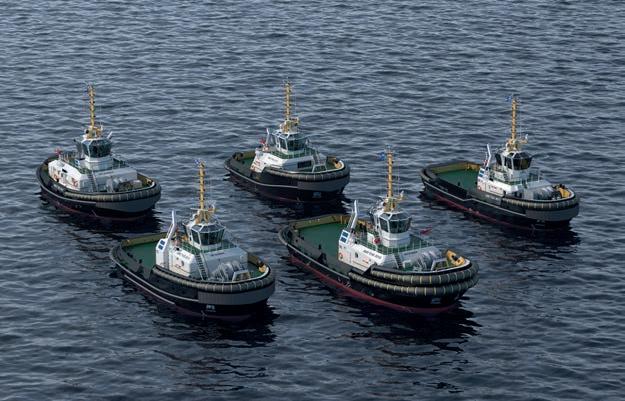
8 An artist’s 3D impression of Damen’s Next Generation series which will capture design enhancements
World to Win if Digital Data Used Correctly
Julian Oggel, Managing Director of Novatug, says “there is a world to win” if digital data is captured and used correctly, but he believes a lot more could be done.
“Tug design is still a very traditional corner with very little imagination about what could be possible. The tug is basically an extrapolation of the original idea of a tool that could help shift a dead ship once it has stopped in port,” he confirms, but is also clear about the issue.
“The current problem is, however, a lot more dynamic and this calls for a different solution. Not a tool aimed at static pull, but one that can assist at speed and do so in an energy-efficient manner, so it is also clean. ICT (Information and communications technology) can help understand the problem parameters and show possibilities for solving those in an integrated way and this should then filter through to design changes.”
Novatug captures data such as line forces and vectors, fuel flow, propeller thrust, speed through the water, time and vessel heading. These are analysed relative to each other and give a clear indication of tug effectiveness and efficiency. “We measure a typical ratio of Kw of engine power added per ton of Kline force generated as a proxy for the tug’s (energy) efficiency. We learned that per ton of line force generated during an assistance (which is the ultimate aim of a tug) the CRT [Novatug’s Carrousel Rave Tug] can save up to 80% of energy needed to pull compared to traditional tugs,” Oggel confirms. Digitalisation capture has helped Novatug’s measurement and simulation of different settings, particularly the position of the VSP units relative to hull length and position of the Carrousel ring, and the hull shape which is optimised for resistance. Oggel explains further. “Since the CRT works on hydrodynamic properties of the hull rather than on engine power to generate its forces, and surprisingly little is known about hydrodynamics, the data collected by the system is also used to train masters and (in the future) give real-time advice to crews about optimal operations.”
He also says that the use of sensors measuring parameters like vibration, acceleration, fuel consumption, load and emissions, all analysed relative to each other, in time helps plan maintenance. While Novatug does not believe fully autonomous tugs will be possible for the foreseeable future, it firmly believes in “computer-assisted-towing”, with the tug crews getting more and better real-time information and advice about tug performance.
LOW-HANGING FRUIT Oggel is clear about the process from today. “The first step, which is really low-hanging fruit, of tug digitalisation is to provide much more situational awareness to tug crews, pilots and assisted vessels’ crews alike about the actual effect of tugs in port and what resources are being applied to reach that. This is hard as in the chain of maritime logistics everybody (tug operators, pilots, port authorities) traditionally works in a silo. Getting benefits from IT starts with having a full and complete picture.”
He is also certain what needs to occur first. “The ‘C’ for communication in “ICT” is often neglected and we feel that we first need to make sure we have access to the right information before we can complete the system to be optimal.”
TIMELY TERMINAL BOOST FOR WILSON, SONS
Major Brazilian shipping group, Wilson, Sons has received a boost as shipping lines are bringing additional cargo to the company’s two terminals, as Rob Ward confirms
In the January-February edition of Port Strategy, it was reported that Wilson, Sons had removed its two terminal operations from the market due to lack of a suitable offer.
Now, the diversified Brazilian shipping group, has received a major boost for these same two facilities with news that CMA CGM and other carriers are now preferring to offload their River Plate transhipment cargo at Tecon Rio Grande (in the far South of Brazil) and Tecon Salvador (in the Brazilian northeast region).
For many years, shipping lines have been running “simulations” and researching “options” to avoid the extra two to three days sailing down to the River Plate [from Rio Grande], especially with the restricted draft making it almost impossible for the larger vessels calling East Coast of South America to berth at Buenos Aires these days.
Now, with improved and expanding cabotage (Brazil) and Gran Cabotage services (Big Cabotage basically means sailing up and down the East Coast of South America, calling in Uruguay and Argentina as well) the options for carriers have never been greater.
As a result, Mercosul Line (CMA CGM), Alianca Navegacao (Hamburg Sud/Maersk Line) and Brazilian owned LogIn Logistica Ltda, are all providing numerous services from Manaus – in the Amazonas jungle region – all the way to the south of Brazil, and then Montevideo (Uruguay) and turning at Buenos Aires and/or Zarate and La Plata (Argentina).
With the Sirius/Bossa Nova service, in which CMA CGM operates two vessels and Maersk Line five ships, Tecon Salvador is to become the hub for CMA CGM’s Argentina/ Uruguay import cargo from the Mediterranean and TRG will load Argentine/Uruguay export cargoes from now until further notice.
Demir Lourenco, the executive director for Tecon Salvador, said that the re-configuration will add around 500 TEU per month and 6,000 TEU per year to the already rising volumes handled by the Wilson, Sons terminal. There will be an even bigger boost for TRG in the south.
“This arrangement is great news for us and it is good timing as from March or April of this year we will also see our new berth come on-stream,” he told Port Strategy. “This will double our berthing length allowing us to handle two large ships and one smaller vessel simultaneously. It will increase our annual capacity from 430,000 TEU up to 530,000 TEU.”
Lourenco added that Tecon Salvador can currently handle vessels of up to 307m in length but when the new berth configuration is operational over the next few months it will be able to handle vessels up to 366m in length, which are yet to call in the ECSA trades.
Leandro Carelli Barreto, a consultant and director for the Solve Shipping consultancy based in Sao Paulo, also endorsed the simulation process previously undertaken. “When I worked at Hamburg Sud a few years ago we spent more than 10 years simulating the movement of cargo to the River Plate and the transhipment possibilities but back then the Transhipment costs were higher than the savings made on cutting one vessel from the schedule,” explained Barreto, adding, “Also the volumes of Argentine import cargo were very high. However, now that these costs have been reduced, owing to more competition at key Brazilian ports, and the Argentine financial crises, imports are way down, this system is now cost effective.”
Barreto further explained that congestion at Santos is causing carriers to find alternative ports for transhipment and so this agreement between the French carrier and Wilson, Sons seems ideal.
Tecon Salvador has already seen an upturn in cabotage and import cargo over the past three years and recently released throughput figures showing that a record 211,540 TEU were handled during 2019, up 4% on 2018. Of those boxes, some 44,149 TEU were import containers, representing an impressive 12% over the 39,439 TEU moved in the previous year. Cabotage hit 50,101 TEU in 2019, up 5%.
As well as TRG and Tecon Salvador Wilson, Sons also operates dry ports, two Offshore Support Bases (for supply vessels), a shipping agency, a shipyard and a tug operation. However, it will be encouraged by the latest developments, especially coming so soon after deciding that the terminals were no longer for sale.
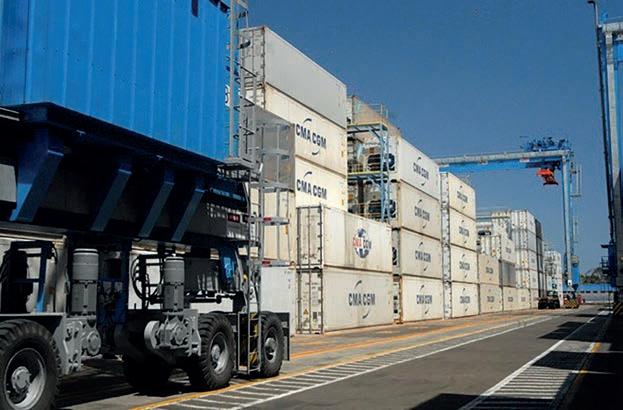

8 CMA CGM is one of several carriers to offload transhipment cargo at Tecon Rio Grande
8 Wilson, Sons gains a timely terminal boost at both its port facilities
Via Praimbole 38, 35010 Limena (PD) – Italy Tel: : +39 049 7663100 Fax: +39 049 8848006 Email: sales@bedeschi.com Web: www.bedeschi.com Bedeschi S.p.A For more than a century, Bedeschi is providing effective and reliable solutions in a wide variety of industries (bulk handling, marine logistics and mining), capitalizing on synergies and cross competences.
B ULK HANDLING
VIGAN Engineering s.a. Rue de l’Industrie, 16 1400 Nivelles (Belgium) Tél.: +32 67 89 50 41 www.vigan.com info@vigan.com VIGAN manufactures dry agribulk materials handling systems: • Portable pneumatic conveyors or grain pumps; • Pneumatic continuous barge and ship unloaders; • Mechanical continuous ship unloaders; • Mechanical loaders;
Complete turnkey projects for port terminals
3690 N Church Avenue Louisville, MS 39339 USA +1 662 773 3421 contactus@taylorbigred.com www.taylorbigred.com Taylor Machine Works, Inc. Taylor Machine Works designs, engineers, and manufactures more than 100 models of industrial lift equipment with lift capacities from 6,000-lbs. to 125,000-lbs. YOU CAN DEPEND ON BIG RED! Fårtoftvej 22 7700 Thisted, Denmark Tel: 0045 72 42 24 00 holding@cimbria.com www.cimbria.com A/S Cimbria Cimbria design, develop, manufacture and install custom-built solutions, from processing lines to large turnkey projects. We possess in-depth specialist knowledge in every field of crops and products with project engineering and process control as particularly demanding fields of competence. C AR GO HANDLING EQUIPMENT Neuro Directory Jan-Feb 2020_Neuero 29/
NEUERO Industrietechnik GmbH
Specialist for pneumatic ship unloaders and mechanical ship loader. NEUERO follows the MADE IN GERMANY quality tradition. Now with more than100 years of tradition in the manufacture of reliable and high-quality conveyor systems worldwide.
Email: neuero@neuero.de Tel: +49 5422 9 50 30 neuero.de/en/
SAMSON Materials Handling Ltd specialises in the design and manufacture of mobile bulk materials handling equipment for surface installation across multiple industrial segments. Designed for rapid onsite set-up and continuous high performance SAMSON equipment provides an excellent return on investment. Gemini House Cambridgeshire Business Park, 1 Bartholomew’s Walk, Ely Cambridgeshire CB7 4EA England, United Kingdom (UK) Tel: +44 1353 665001 Fax: +44 1353 666734 sales@samson-mh.com www.samson-mh.com
C ARGO HANDLING SYSTEMS
Rudolf-Diesel-Str 111 D-46485 Wesel, Germany Tel: +49 (0) 281 - 9 59 90 - 0 info@lase.de www.lase.de LASE Industrielle Lasertechnik GmbH LASE offers innovative and productive solutions for ports by combining state-of-the-art laser scanner devices and sophisticated software applications. We are specialised in the fully automated handling of containers, cranes or trucks.
C OMPONENTS
P4.1 e-chain® Energy chain with optional intelligent wear monitoring for double the service life, travels of up to 1.000 m, speeds of up to 10 m/s and fill weights of up to 50 kg/m.
igus® GmbH Spicher Str. 1a D-51147 Köln, Germany Tel. +49-2203-9649-0 info@igus.eu igus.eu/P4.1
C ONSULTANTS
C ONSULTING ENGINEERS
Container Terminal Altenwerder, Am Ballinkai 1 21129 Hamburg, Germany T: +49 (0)40 74008-0 info@hpc-hamburg.de www.hpc-hamburg.de HPC Hamburg Port Consulting GmbH HPC is an internationally renowned consulting firm with profound experience in the global port, transport and logistics sector and a clear operations/owner’s perspective.
Jacobs has served the global port industry for 150 years. As one of the world’s largest port consultancies, our unequaled talent delivers innovation and technical excellence to solve your greatest challenges.
500 Seventh Avenue New York, NY, 10018, USA Tel: +1 646 908 6550 Patrick.King@jacobs.com www.jacobs.com/capabilities/ transportation
C RANE COMPONENTS
Tel: +65 9186 6846 jon.arnup@trent-global.com www.trent-global.com/ When experience really does matter! Over a century of port industry experience. A strategic group of ‘best in breed’ people, partners and solutions, capable of delivering holistic, turn-key, advanced port-centric solutions for any brown and greenfield terminal around the world.
G-SERIES
Tel: : +46-(0)157-45 43 40 Fax: +39 049 8848006 Email: info@dellnerdampers.se Web: dellnerdampers.se Dellner Dampers is an innovative Swedish company that supplies solutions to mitigate vibrations and absorb kinetic energy. Standard and customised buffers and dampers for port side applications such as cranes, spreaders and more. All designed and produced in Sweden.
D REDGING
WASA Dredring Directory_Wasa Directory Nyhavn 20 Copenhagen K. DK-1051 Denmark +45 33 91 25 07 mail@rohde-nielsen.dk www.rohde-nielsen.dk Rohde Nielsen A/S Specialising in capital and maintenance dredging, land reclamation, coast protection, Port Development, Filling of Caissons, Sand and Gravel, Offshore trenching and backfilling
D REDGING EQUIPMENT
E LE CTRIFICATION SOLUTIONS
DEME Directory Jan 2020_DEME Directory
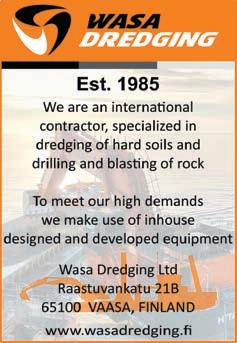
Staubli directory 40x58_Stäubli 29/01/2020 DEME is a world leader in the highly specialised fields of dredging, marine engineering and environmental remediation. The company can build on more than 140 years of know-how and experience and has fostered a pioneering approach throughout its history, being a frontrunner in innovation and new technologies. Scheldedijk 30, Haven 1025 2070 Zwijndrecht, Belgium +32 3 250 52 11 info.deme@deme-group.com www.deme-group.com
As one of the leading manufacturers of quick connector systems, Stäubli covers connection needs for all types of fluids, gases and electrical power.
+41 61 306 55 55 ec-ch@staubli.com www.staubli.com/en-ch/ connectors/
VAHLE PORT TECHNOLOGY
VAHLE is the leading specialist for mobile power and data transmission VAHLE provides the solutions to reduce the carbon footprint while increasing the productivity. RTGC electrification including positioning and data transmission making RTGC ready for Automation.
Westicker Str. 52, 59174 Kamen, Germany Email: port-technology@vahle.de Web: www.vahle.com
G RABS
Marconibaan 20 Nieuwegein Netherlands 3439 MS Tel: +31-30-6062222 Fax: +31-30-6060657 info@verstegen.net www.verstegen.net Verstegen Grijpers BV Verstegen is worlds leading manufacturer of rope operated mechanical grabs for the dry bulk industry. Stevedoring companies and ports are using our grabs for handling all kinds of bulk materials.
Alimak Group Sweden AB Alimak, the leading manufacturer of rack and pinion elevators, have been successfully servicing ports since the early 1970s with close to 3,000 elevators installed, providing easy access for crane drivers, which enhances productivity and profit. Today, the company’s crane elevators are installed in almost 100 countries around the world.
info@alimak.com www.alimak.com
Talweg 15-17, Helmstadt-Bargen 74921, Germany Tel: +49 (0)7263 - 91 29 0 Fax: +49 (0)7263 - 91 29 12 info@mrs-greifer.de www.mrs-greifer.de MRS Greifer GmbH Grabs of MRS Greifer are in use all over the world. They are working reliably and extremely solid. All our grabs will be made customized. Besides the production of rope operated mechanical grabs, motor grabs and hydraulic grabs we supply an excellent after sales service.
H ANDLING EQUIPMENT
BLOK cuts Shipping Line pollution: increases safety and productivity in Port • BLOK Spreader – lifts 4x40’ empties • BLOK Rig – automatic twistlocking • BLOK Trailer – 8 teu BLOK Container Systems Ltd
Tel: 00441926611700 enquiries@blokcontainersystems.com www.blokcontainersystems.com
Gerbestr. 15, 6971 Hard, Austria T: +43 5574 6883 0 sales@kuenz.com www.kuenz.com Künz GmbH Founded in 1932, Künz is now the market leader in intermodal rail-mounted gantry cranes in Europe and North America, offering innovative and efficient solutions for container handling in intermodal operation and automated stacking cranes for port and railyard operations.
H ANDLING EQUIPMENT
I NSURANCE
Sany Europe GmbH
SANY offers reliable quality container handling trucks. Benefit from the experience of over 4,000 reach stackers build over the last 12 years, with up to five year full machine warranty.
Sany Allee1 D-50181 Bedburg Tel: +49 2272 90531 100 Email: info@sanyeurope.com www.sanyeurope.com
The TT Club is the international transport and logistics industry’s leading provider of insurance and related risk management services. TT Club specialises in the insurance of liabilities and equipment for multi-modal operators.
90 Fenchurch St London • EC3M 4ST Tel: +44 207 204 2635 london@ttclub.com www.ttclub.com
I T PORT AUTOMATION
Technologielaan 13 Leuven, Belgium +32-16-38-9272 +32-16-38 9274 info@camco.be www.camco.be CAMCO Technologies NV Visual- and Micro Location- assisted process automation solutions for container, ro-ro and rail terminals worldwide. Accurate crane, gate & rail OCR systems and Gate Operating System software helping terminals accelerate terminal and gate activity.
I T PORT AUTOMATION
M ARINE FENDERS
VISY Oy VISY takes pride in solving operational problems, specialising in gate automation and access control solutions in ports and terminals. Their solutions streamline processes resulting in saving money and increasing productivity. Tel: +358 3 211 0403 Email: sales@visy.fi Web: www.visy.fi/
info@shibata-fender.team www.shibata-fender.team ShibataFenderTeam Group ShibataFenderTeam is one of the leading fender manufacturers with 50+ years of group experience and an extensive global network. As a specialist for customized fender solutions, they focus on vertical integration with in-house manufacturing and full scale testing, offering high quality products at competitive prices. SFT offers the full range of marine fender products.
P OWER TRANSMISSION
Rheinstrasse 27 + 33 Weil am Rhein 79576 Germany Tel: +49 (0) 7621 662 0 Fax: +49 (0) 7621 662 144 info.de@conductix.com www.conductix.com Conductix-Wampfler The world specialist in Power and Data Transfer Systems, Mobile Electrification, and Crane Electrification Solutions. We Keep Your Vital Business Moving!
Schwartauer Str. 99 D-23611 Sereetz • Germany Tel:+49 451 398 850 Fax: +49 451 392 374 soj@orts-gmbh.de www.orts-grabs.de Orts GMBH Maschinenfabrik Over 40 years experience constructing and manufacturing a wide range of grabs, including electro-hydraulic grabs (with the necessary crane equipment) radio controlled diesel hydraulic grabs, 4, 2 and single rope grabs all suitable for bulk cargo.
Liebherr-MCCtec Rostock GmbH Liebherr provides advanced maritime cargo handling solutions with a focus on quality, innovation and performance. With more than 50 years’ experience in vessel handling and container stacking, Liebherr supplies premium port equipment for highly efficient port operations across the globe.
Liebherrstraße 1, 18147 Rostock Rostock, Germany +49 381 6006 5020 maritime.cranes@liebherr.com www.liebherr.com CERTUS provides Automatic Container Recognition systems in ports and terminals all across the globe. Our systems have consistently demonstrated high reliability and overall high OCR accuracy, streamlining customer operations. Check out our Mobile OCR!
www.certus port automation.com
+31 78 6815196 The Netherlands
9 11 TO JUNE 2020 Southampton United Kingdom
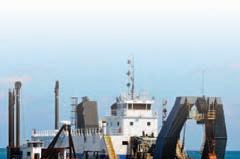

Brabantstraat 15 BE-8790 Waregem Tel: +32 56 43 42 11 Fax: +32 56 43 44 88 info@tvh.com www.tvh.com TVH PARTS NV TVH supplies every part you need for heavy forklifts, reach stackers, container handlers, spreaders and terminal tractors. As a one-stop shop, the company offers a full service in spare parts and accessories for container handling equipment, with a guaranteed fast delivery at a competitive price.
Malaxgatan 7 , P.O. Box 1133 SE-164 22 Kista, Sweden Tel: +46 8 620 09 00 Fax: +46 8 739 37 86 sales@bromma.com spareparts@bromma.com Bromma Conquip Bromma is the industry’s most experienced spreader manufacturer, known worldwide for crane spreaders of exceptional reliability. Today you find Bromma spreaders operating in 97 out of the top 100 ports worldwide.
T ERMINAL OPERATIONS SYSTEMS
DSP Data and System Planning SA Via Cantonale 38 6928 Manno, Switzerland Tel: +41 91 230 27 20 Fax: +41 91 230 27 31 info@dspservices.ch www.dspservices.ch The Brain of Logistics With more than 30 years experience in IT Solutions and Business Operation Consultancy DSP offers a large portfolio of professional services and products to support terminal operations processes and system.
T ERMINAL OPERATIONS SYSTEMS
Prinses Margrietplantsoen 33, 2595AM, The Hague, The Netherlands Tel: +31 (0) 702-051-709 Email: sales@solvosys.com www.sovosys.com Solvo Europe B.V. Solvo’s software solutions such as TOS or WMS help container and general cargo terminals take full care of their cargo handling processes and make sure the clients expectations are exceeded.
World Headquarters 55 Harrison Street Suite 600 Oakland CA 94607 United States Tel: +1 510 267 5000 Fax:+1 510 267 5100 Web: www.navis.com Navis understands that as ships get larger and operational processes become more complex - efficiency, collaboration and productivity are essential. As a trusted technology partner, Navis offers the tools and personnel necessary to meet the requirements of a new, and ever-evolving, global supply chain.
Tideworks Technology provides comprehensive terminal operating system solutions for marine and intermodal terminal operations worldwide. Tideworks works at every step of terminal operations to maximize productivity and customer service. info@tideworks.com +1 206 382 4470 www.tideworks.com
Stalgatan 6 , PO Box 174 SE 343 22, Almhult, Sweden Tel: +46 47655800 Fax: +46 476 55899 sales@elme.com www.elme.com ELME Spreader AB ELME Spreader, world’s leading independent spreader manufacturer supports companies worldwide with container handling solutions that makes work easier and more profitable. Over 21,000 spreaders have been attached to lift trucks, reach stackers, straddle carriers and cranes.
9 11 TO JUNE 2020 Southampton United Kingdom


www.mcceexpo.com
Tel : +33 (0)3 28 65 81 91 contact@tgims.com www.tgims.com TGI Maritime Software is a Terminal Operating System editor and integrator specialized in the support of Small to Medium Terminals. Its expertise is built on 34 years of experience within the maritime sector. TGI provides comprehensive services to its customers all along their projects. OSCAR TOS and CARROL TOS have already been successfully handled by 40 container and RoRo terminals worldwide.
T ERMINAL OPERATIONS SUPPORT
Providing complete solutions for your container cranes Refurbishments & Upgrades –Maintenance – Training – Inspections & Audits – Safety Lashing Cages –Spares & Service Support www.wcs-grp.com/ info@wcs-grp.com T: +971-4-8838980

9 11 TO JUNE 2020 Southampton United Kingdom
T RACTORS
www.mcceexpo.com

MAFI Transport-Systeme GmbH
Specialised in the development and production of heavy-duty equipment for transporting containers, semi-trailers, cargo/roll trailers and special container chassis in ports and industry.
Hochhäuser Str 18 97941 Tauberbischofsheim, Germany Tel: +49 9341 8990 sales@mafi.de www.mafi.de
For the latest news and analysis go to www.portstrategy.com/news
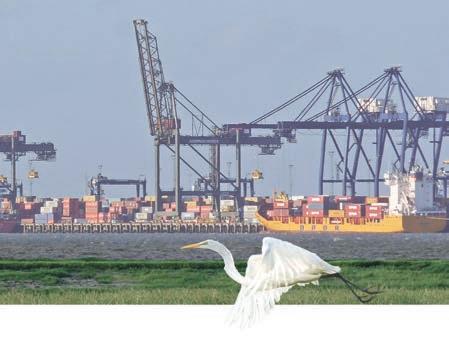

DECEMBER 2019 | 53 SUBSCRIBE NOW to receive a trial copy of GreenPort Magazine
• Comprehensive online directory • Instant access to industry news • eNewsletter • Magazine subscription • Expert opinion
www.greenport.com
Nigeria’s port sector is on the comeback trail with traffic volume. While, however, previous highs have not yet been attained new port development is proceeding and a flurry of new investment in conjunction with existing terminals
NIGERIA: EXPANDING DESPITE TRAFFIC SETBACKS
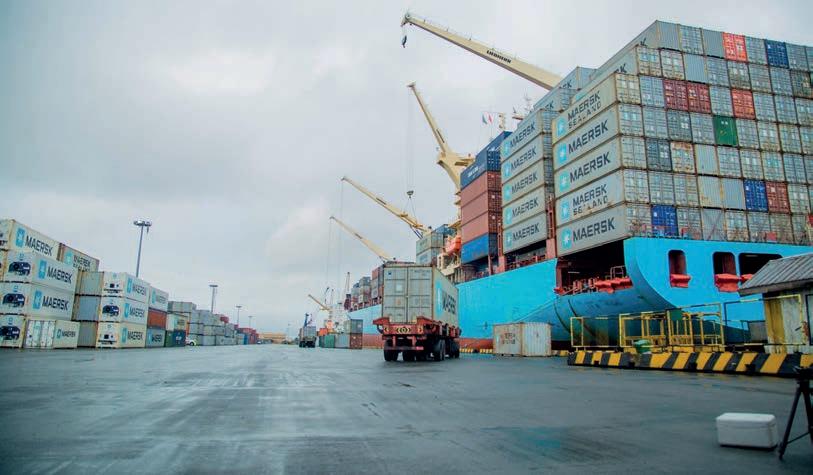
Nigeria, Africa’s most populous country with over 200 million inhabitants, is often cited as a land of great potential but as seen time and time again it has been slow to realise it and ,accordingly, port development has proceeded at a measured pace. This remains the case today with port investment largely following forecast economic prospects, although after nearly a decade financing has at last been secured for the new port of Lekki in Lagos State.
In October 2019 agreements were signed with the China Development Bank including a USD$629 million financing facility that government officials said would accelerate the completion of the Lekki deep-sea port project. Completion was put at 30 months, which appears to be highly ambitious and will likely lengthen. This may also be appropriate given the reality that Nigeria’s overall non-oil related cargo volumes are still in recovery from previous highs with the container sector included in this. Further, while there is, generally, significant economic potential the actual economic forecasts are not yet that bright - Real GDP growth is projected to rise to 2.9% in 2020 and 3.3% in 2021. But this depends on implementing the Economic Recovery and Growth Plan (2017–20), which emphasises economic diversification.
The latter has, of course, traditionally proved problematic, one significant factor being foreign investors deterred by security problems. Also, as the African Development Bank poignantly notes, “The poverty rate in over half Nigeria’s 36 states is above the national average of 69%. High poverty reflects rising unemployment, estimated at 23.1% in 2018, up from 14.2% in 2016. Low skills limit opportunities for employment in the formal economy.”
In cargo throughput terms the challenge is also clear. For 2013, a total container volume in Nigeria was of over 1,700,000 TEU and the latest statistics available from the Nigerian Ports Authority (NPA) give a volume of 1,210,000 TEU for 2018. The
8 The West Africa Container Terminal is due to commence a comprehensive Phase 2 upgrade in the next 18 months
situation with total cargo throughput excluding crude oil is even more dramatic, from a high of over 80 million tonnes in 2011 the volume had fallen to just under 36 million tonnes in 2018.
This overall situation clearly presents a challenge for new port developers. While the Lekki concession is for 45 years a good kick-start to a new development is most beneficial.
BUILDING EXISTING BASES Meanwhile two existing container terminal operators have just announced investment plans.
The SIFAX Group company Ports and Cargo Handling Services Limited, located on Tin Can Island, has introduced three new, high capacity, Liebherr mobile cranes for across the quay operations as well as two more second-hand units. These units are particularly intended to match the latest vessel types calling at the terminal. Also acquired as part of a comprehensive terminal upgrade package are nine reach stackers and 10 terminal tractors.
The company has just one year left to run on its concession period, it has submitted a bid for an extension and with the investment undertaken is clearly confident of getting it.
Similarly, the West Africa Container Terminal at Onne, offering a gateway to Eastern Nigeria and an alternative to the Lagos terminals, has announced what it describes as a Phase 2 upgrade scheduled to commence over the near term. Terminal operator APM Terminals states:
“The Phase 2 upgrade includes the acquisition of three additional mobile cranes bringing the total in operation to five; 20 rubber-tyred gantry cranes (RTGs), three reach stackers, 13 terminal trucks and trailers and an empty container handler.”
14 16 TO OCT 2020 Athens Greece



2020Athens 2020Athens 2020Athens
BOOK NOW AND SAVE 20%
*use code ‘early’

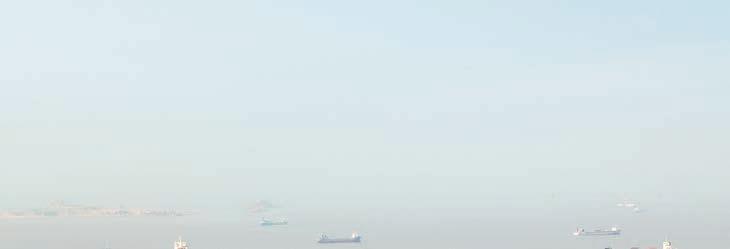

BOOK NOW AND SAVE 20% The world’s leading conference on balancing environmental challenges with economic demands comes to Athens. *use code ‘early’ BOOK NOW AND SAVE 20% The world’s leading conference on balancing environmental challenges with economic demands comes to Athens. *use code ‘early’ The world’s leading conference on balancing environmental challenges with economic demands comes to Athens.
SAVE €390 on Cruise & Congress
*Full price €1950
SAVE €199 on Cruise


SAVE €390 on Cruise & Congress Delegate place includes: • Choice of conferences streams for Greenport Cruise on day 1 • Two day conference attendence at Greenport Congress • Full documentation in electronic format • Lunch and refreshments throughout • Place at the Welcome Reception • Place at the Gala Dinner •Place at the Port Tour *Full price €1950 SAVE €390 on Cruise & Congress Delegate place includes: • Choice of conferences streams for Greenport Cruise on day 1 • Two day conference attendence at Greenport Congress • Full documentation in electronic format • Lunch and refreshments throughout • Place at the Welcome Reception • Place at the Gala Dinner •Place at the Port Tour *Full price €1950 Delegate place includes: • Choice of conferences streams for Greenport Cruise on day 1 • Two day conference attendence at Greenport Congress • Full documentation in electronic format • Lunch and refreshments throughout • Place at the Welcome Reception • Place at the Gala Dinner •Place at the Port Tour *Full price €995
• One day conference attendance • Full documentation in electronic format • Lunch and refreshments • Place at Welcome Reception • Place at the Conference Dinner SAVE €199 on Cruise *Full price €995 • One day conference attendance • Full documentation in electronic format • Lunch and refreshments • Place at Welcome Reception • Place at the Conference Dinner SAVE €199 on Cruise *Full price €995 • One day conference attendance • Full documentation in electronic format • Lunch and refreshments • Place at Welcome Reception • Place at the Conference Dinner
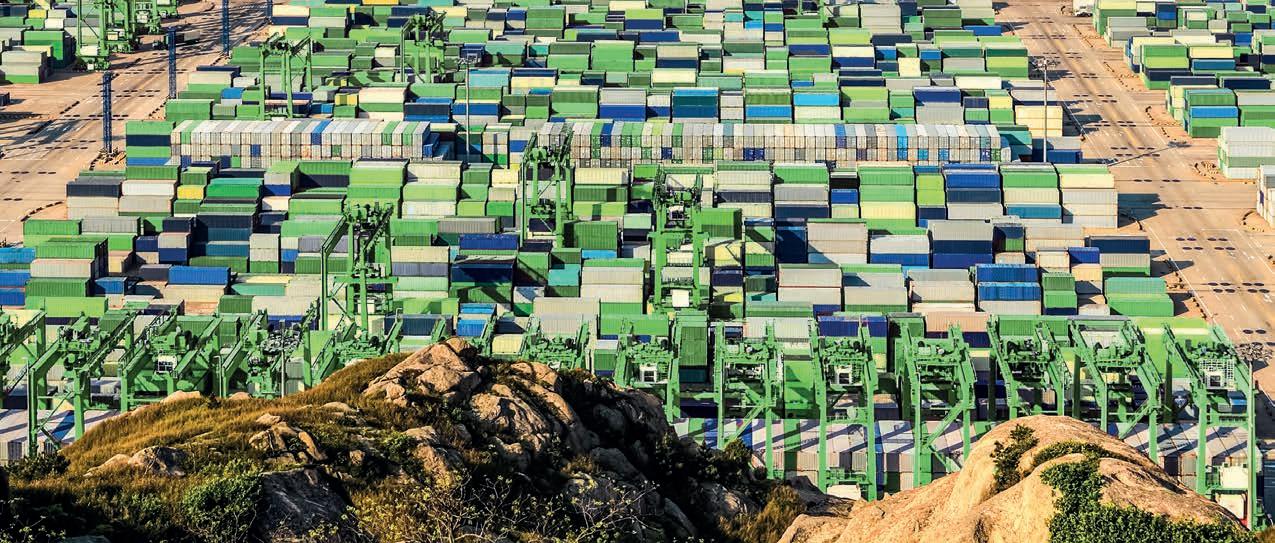
#GPCongress Meet and network with over 200 attendees representing port authorities, terminal operators and shipping lines. For more information on attending, sponsoring or speaking contact the events team visit: greenport.com/congress contact: +44 1329 825335 or email: congress@greenport.com Media Partners: GREENPORT BALANCING ENVIRONMENTAL CHALLENGES WITH ECONOMIC DEMANDS #GPCongress Meet and network with over 200 attendees representing port authorities, terminal operators and shipping lines. For more information on attending, sponsoring or speaking contact the events team visit: greenport.com/congress contact: +44 1329 825335 or email: congress@greenport.com Media Partners: GREENPORT BALANCING ENVIRONMENTAL CHALLENGES WITH ECONOMIC DEMANDS #GPCongress Meet and network with over 200 attendees representing port authorities, terminal operators and shipping lines. For more information on attending, sponsoring or speaking contact the events team visit: greenport.com/congress contact: +44 1329 825335 or email: congress@greenport.com Media Partners: GREENPORT BALANCING ENVIRONMENTAL CHALLENGES WITH ECONOMIC DEMANDS GPCC Athens 2020 BookNow 210x275 06.02.2020.indd 1 06/02/2020 13:02






